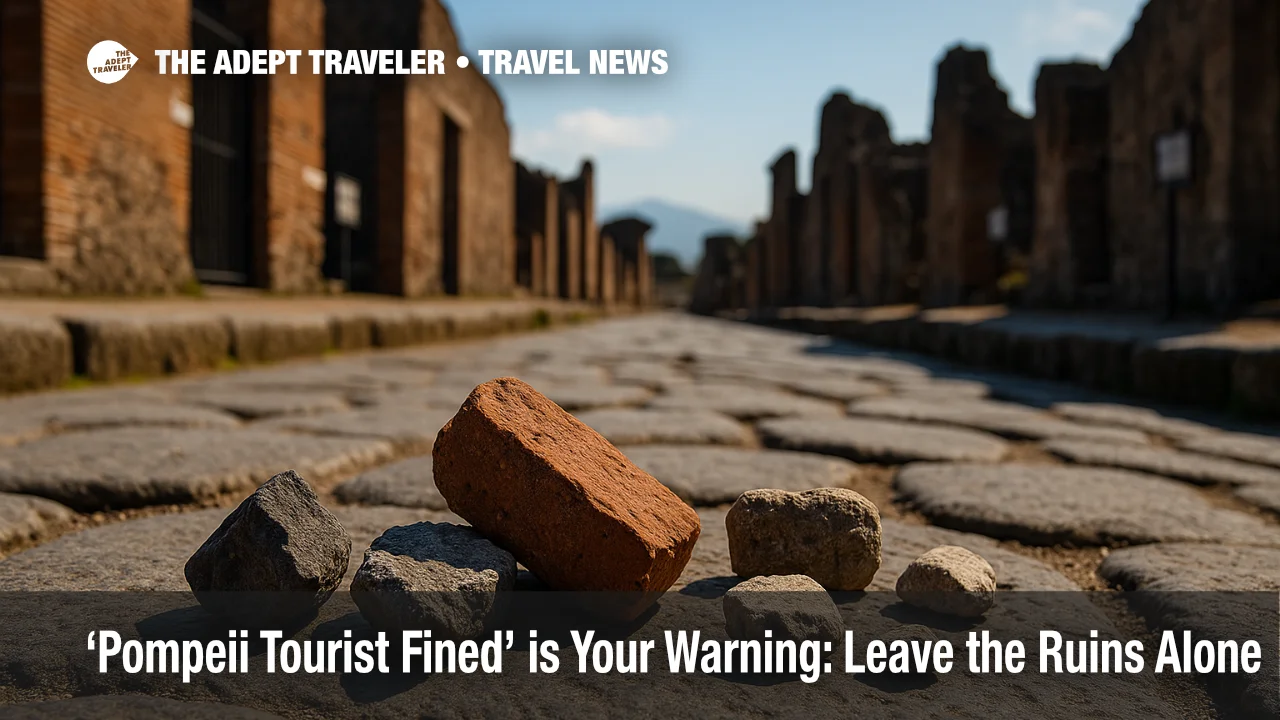'Pompeii tourist fined' is your warning: leave the ruins alone

A 51-year-old British visitor was detained on August 14, 2025, after a guide saw him pocketing stone fragments inside the Pompeii Archaeological Park. Police intercepted him near the Villa dei Misteri EAV station and seized six items from his backpack, five stones and a brick fragment. He was reported for aggravated theft, and the artefacts were returned to the park. Under Italy's cultural-heritage laws, penalties can reach six years in prison and €1,500 in fines, even when the "souvenir" looks like a harmless pebble. Consider this the latest cautionary tale.
Key Points
- Why it matters: Removing artefacts is a crime, not a keepsake. The 'Pompeii tourist fined' case proves authorities are watching.
- Travel impact: Expect vigilant guides, more patrols, and zero tolerance for "found" stones at historic sites.
- What's next: Italy is tightening enforcement across popular destinations, pairing education with penalties.
- Responsible options: Book licensed tours, shop at museum stores, and photograph, do not pocket, history.
- Wider trend: European hotspots are layering rules and fines to protect fragile places.
Snapshot
The British traveler told authorities he wanted to gift the stones to his son's "rare objects" collection and claimed he did not know removal was illegal. Guides and Carabinieri recovered the items quickly, a routine that has become more common as summer crowds swell. The park's director publicly thanked staff, security, and police for coordinated protection of the site. Italy's updated criminal code for cultural property sets stiff penalties for stealing artefacts, so even small fragments can trigger serious consequences. Beyond the law, there is lore, many returned items arrive by mail with apology letters from tourists who say a Pompeii "curse" followed them home.
Background
Pompeii is one of the world's most visited archaeological sites, preserved under ash since A.D. 79. Its scale makes enforcement challenging, which is why park guides and fixed-post Carabinieri units work together on surveillance. Italy overhauled its criminal code in 2022, adding a dedicated section on crimes against cultural heritage. Theft of cultural property now carries tougher prison terms and fines, reflecting how even casual "historic site souvenirs" add up to real loss. For years, the park has also received remorseful packages from travelers who say bad luck plagued them after taking tiles or stones. Whether you believe in curses or not, the legal risk is real, and the ethical line is clear.
Latest Developments
Guide's tip-off leads to seizure near Villa dei Misteri
During an evening tour on August 14, a guide observed a visitor "picking up pieces of pavement" and alerted park staff and security. Carabinieri stationed for the excavations traced the suspect outside the gates, near the Villa dei Misteri EAV stop, and found six artefacts in his backpack. Officers returned the fragments to the archaeological park and reported the tourist for aggravated theft. Authorities say checks will intensify through the peak season. Recent coverage highlights that a court summons is possible, with penalties up to six years in prison and a maximum €1,500 fine, depending on circumstances and criminal history. The message is unmistakable, do not take anything.
Italy's law makes "small" thefts a big deal
Italy's Title VIII-bis of the penal code targets cultural-property crimes. Theft of cultural goods, even minor fragments, is punishable by prison time and fines, with higher ranges when aggravating factors apply. That framework explains why a handful of stones can become a criminal case. It also aligns with a broader push to protect fragile sites and landscapes across Italy. Local rules increasingly penalize destructive behaviors, including removing sand or stones from protected beaches. For a traveler, the takeaway is simple, the law sees artefacts as shared heritage, not souvenirs.
Analysis
This incident is more than a headline. It underlines three truths every traveler should internalize. First, artefacts are not abandoned rubble. A small stone can be part of a documented layer, a construction detail, or context for future research. Pocketing it erases data and forces archaeologists to repair the loss with time and money. Second, the legal shift matters. Italy has moved from loosely enforced site rules to a modern criminal framework that treats cultural theft as a specific offense with real teeth. Third, the norms are changing beyond Pompeii. Municipalities across Italy now pair education with enforcement, from selfie management to beach protections, to curb cumulative harm.
If you want a memento, buy a book, a replica, or a licensed craft. If you want a story, hire a certified guide and take photos that do not need a lawyer's review later. For broader context on how Italy is tightening visitor rules, see Italy Imposes Entry Fees, Selfie Rules, Dress Codes for 2025 and the regional picture in Overtourism 2025: Europe's Hotspots Impose New Rules. The consistent theme is respect, conservation, and accountability, not souvenirs at any cost.
Final Thoughts
The "cursed souvenir" letters make for dramatic copy, but you do not need superstition to do the right thing. Removing stones, shells, or shards degrades sites and can land you in court. Choose photographs, guides, and museum shops, not archaeological fragments, and your memories will travel home without fines, fear, or regret. Let this be the last time we read a story like this, and the last time anyone becomes the next 'Pompeii tourist fined.'
Sources
- British man faces €1,500 fine for stolen Pompeii stones, Euronews
- Pietre dell'antica Pompei come souvenir, ANSA
- Pompei, turista scozzese ruba pietre negli Scavi, Corriere del Mezzogiorno
- Pompei, turista cerca di trafugare dei resti, RAI News
- Italian Criminal Law, Crimes against cultural heritage, Università Cattolica, PDF
- Tourist returns 'cursed' artefacts to Pompeii after 15 years, The Guardian
- Pompeii 'curse' myth, Business Insider
